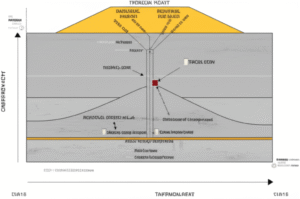The 7 Most Common Mistakes in Gastroenterology Coding: The Ultimate Guide to Optimizing Your Revenue Cycle
Updated for 2025 regulations
Coding Pitfalls
Coding Pitfalls
Introduction
In today’s complex medical coding landscape, gastroenterology presents unique challenges that can significantly impact your practice’s profitability. With constant updates to ICD-10 and CPT codes, changing payer policies, and increasingly stringent regulations, a single coding error can trigger a cascade of financial problems.
Did you know that gastroenterology practices lose an average of 15-20% of their potential revenue due to preventable coding errors?
This comprehensive guide identifies the 7 most critical mistakes and provides proven strategies to eliminate them from your practice.
🚨 Error #1: Incomplete or Insufficient Documentation
The Root of 80% of Denials
The Real Problem
Poor documentation isn’t just an administrative inconvenience; it’s the leading cause of claim denials, costly audits, and lost revenue. Payers require full medical justification for every billed service.
Financial Impact
- Average denial rate : 25-40% for insufficient documentation
- Appeal cost per claim : $25-75
- Resolution time : 30-90 days
The Strategic Solution
1. Implement the SOAP Plus Protocol
- S (Subjective) : Patient-specific symptoms with duration, intensity, and aggravating/relieving factors
- O (Objective) : Detailed physical examination findings and results of previous studies
- A (Evaluation) : Differential diagnosis and clinical reasoning
- P (Plan) : Clear justification for each procedure or treatment
- Plus : Endoscopic photographs with precise measurements where applicable

2. Specific Documentation for Procedures
Ejemplo de Documentación Óptima:
"Colonoscopia realizada por indicación de sangrado rectal intermitente de 3 meses de duración.
Preparación excelente (Boston Bowel Prep Scale 8/9). Cecum alcanzado e identificado por válvula
ileocecal y apéndice. Pólipo sésil de 8mm identificado en colon sigmoide a 25cm del ano.
Polipectomía realizada con asa fría, resección completa confirmada. Especimen enviado a patología."
3. Supporting Technological Tools
- Custom templates in EHR
- Speech recognition with medical terminology
- Automatic alerts for incomplete fields
- Integration with endoscopic imaging systems
⚡ Error #2: Incorrect Selection of CPT Codes
The Art of Technical Precision
Most Frequent Errors
- Confusing screening vs. diagnosis (40% of errors)
- Generic codes instead of specific ones (25% of errors)
- Punto de inserción incorrecto en endoscopies (20% de errores)
- Similar procedures with different nuances (15% errors)
Prevention Strategy
Decision Matrix for Colonoscopies
| Scenery | Base Code | Special Considerations |
|---|---|---|
| Routine screening (asymptomatic) | 45378 | Patient without symptoms, without history of polyps |
| Diagnostic (symptomatic) | 45378 | Document symptoms clearly |
| Therapeutics (polypectomy) | 45385 | If started as screening, use modifier -PT |
| Sigmoidoscopia flexible | 45330 | Confirm that the transverse colon was not reached |
CPT Code Verification: Checklist
- [ ] Does the code reflect the furthest point examined?
- [ ] Does the documentation justify the level of complexity?
- [ ] Was the most specific code available applied?
- [ ] Were all interventions carried out considered?
🎯 Mistake #3: Misuse of Modifiers
The Secret Language That Maximizes Refunds
Critical Modifiers in Gastroenterology
Modifier -PT (Medicare)
Use : Screening colonoscopy that becomes therapeutic Benefit : Maintains deductible and coinsurance waiver Example : 45385-PT (polypectomy that began as screening)
Modifier Family -X{EPSU} (Preferred over -59)
- XE : Services in separate encounters
- XS : Services at separate anatomical sites
- XP : Services by different professionals
- XU : Unusual non-overlapping services
Modifier -53 (Discontinued Procedure)
Required documentation : Specific medical reason for discontinuation
Ejemplo: "Colonoscopia discontinuada a 15cm debido a preparación inadecuada
que impide visualización segura. Paciente reprogramado tras nueva preparación."
Verification Tools
- Integrated NCCI editing software
- Automatic alerts for incorrect combinations
- Monthly modifier usage audits
🔗 Error #4: Diagnosis-Procedure Disconnection
Medical Necessity as a Legal Basis
The Fundamental Principle
Each procedure = Diagnosis that justifies it
Effective Linking Strategies
ICD-10 Code Hierarchy
- Specific with laterality and stage (preferred)
- Specific without laterality (acceptable)
- General or “unspecified” (last resort)
Examples of Correct Linking
| Procedure | Weak Diagnosis | Strong Diagnosis |
|---|---|---|
| Colonoscopy | K59.9 (Intestinal disorder NE) | K92.1 (Melena) + R19.5 (Abnormal stool) |
| EGD | K30 (Dyspepsia) | K92.0 (Hematemesis) + K25.9 (Gastric ulcer) |
| ERCP | K83.9 (Biliary disease NE) | K80.50 (Choledocholithiasis without cholangitis) |
Validation Resources
- LCDs (Local Coverage Determinations) actualizadas
- NCDs (National Coverage Determinations)
- Specific policies for commercial payers
🔬 Error #5: Incorrect Endoscopies Coding
Screening vs. Diagnosis: The Difference of Thousands of Dollars
Real Financial Impact
- Average error per miscoded colonoscopy : $200-400
- Claims affected monthly in average practice : 15-25
- Potential annual loss : $36,000-120,000
Infallible Decision Protocol
Classification Algorithm
PREGUNTA 1: ¿El paciente tiene síntomas gastrointestinales?
├─ SÍ → DIAGNÓSTICA/TERAPÉUTICA
└─ NO → Continuar a Pregunta 2
PREGUNTA 2: ¿Antecedentes de pólipos, cáncer colorrectal o IBD?
├─ SÍ → DIAGNÓSTICA/TERAPÉUTICA
└─ NO → Continuar a Pregunta 3
PREGUNTA 3: ¿Se encontraron y trataron lesiones durante el procedimiento?
├─ SÍ → TERAPÉUTICA con modificador -PT (Medicare)
└─ NO → CRIBADO

Protective Documentation
- Record absence of symptoms for screening
- Document specific symptoms for diagnosis
- Photograph and measure all injuries found
- Explicit note if screening becomes therapeutic
📦 Error #6: Bundling/Unbundling Issues
Navigating CMS Grouping Rules
Key Concept: NCCI Edits
The National Correct Coding Initiative defines which procedures:
- They are billed together (bundled)
- They are billed separately (unbundled)
- Modifiers are required to justify separate billing.
Golden Rules for Gastroenterology
Always Bundled (Do not bill separately)
- Biopsy during basic diagnostic EGD
- Air insufflation during colonoscopy
- Lavage/irrigation during endoscopy
Separate Billing Allowed
- Polypectomy + biopsy of different area (with modifier)
- EGD + colonoscopy on the same day (different organs)
- Multiple polypectomies with different techniques
Automated Verification System
- Software with updated NCCI database
- Pre-billing alerts for problematic combinations
- Monthly review of grouping patterns
✅ Error #7: Verification and Pre-Authorization Failures
The First Line of Financial Defense
The Cost of Not Verifying
- Claims denied due to lack of authorization : 30-60% at some payers
- Average time to resolution : 45-120 days
- Additional administrative burden : 2-4 hours per claim
Elite Verification System
48-Hour Protocol
- 48 hours before the procedure : Complete eligibility verification
- 24 hours before : Confirmation of prior authorization if required
- Day of procedure : Final verification of active status
Automation Tools
Dashboard de Verificación Diaria:
┌─ Pacientes programados próximos 7 días
├─ Estado de elegibilidad (Verde/Amarillo/Rojo)
├─ Autorizaciones pendientes
├─ Deducibles y copagos estimados
└─ Alertas de vencimiento de autorización
High Risk Procedures (Authorization Almost Always Required)
- ERCP
- EUS (Endoscopic Ultrasound)
- Capsule endoscopy
- Complex therapeutic procedures
- Multiple procedures in a single day
🚀 Implementation: Your 90-Day Action Plan
Days 1-30: Audit and Diagnosis
- [ ] Retrospective audit of last 100 claims
- [ ] Identification of specific error patterns
- [ ] Assessment of current staff and training needs
- [ ] Selection of support technological tools
Days 31-60: Systems Implementation
- [ ] Intensive training of the coding team
- [ ] Implementation of improved documentation templates
- [ ] NCCI Verification Software Configuration
- [ ] Establishing prior authorization workflows
Days 61-90: Optimization and Monitoring
- [ ] Weekly quality audits
- [ ] Process refinement based on initial results
- [ ] Reinforcement training for problem areas
- [ ] Establishing continuous performance metrics
📊 Success Metrics: KPIs to Monitor
Financial Indicators
- Initial denial rate : < 5% (target)
- Days in accounts receivable : < 35 days
- Percentage of clean claims : > 95%
- Average appeal resolution time : < 30 days
Quality Indicators
- Coding accuracy in audits : > 98%
- Complete documentation : > 95% of records
- Correct use of modifiers : > 97%
- Successful eligibility checks : > 99%

💡 Conclusion: Turning Mistakes into Opportunities
Excellence in gastroenterology coding isn’t just about regulatory compliance; it’s a competitive advantage that directly translates into:
✅ Improved and predictable cash flow
✅ Significant reduction in administrative stress
✅ Increased patient satisfaction through clear billing
✅ Protection against audits and penalties
✅ Ability to reinvest in technology and medical staff
The Next Step
Successful implementation requires commitment, but the results are transformative. Practices that have adopted these principles report average improvements of:
- 20-30% reduction in denials
- 15-25% improvement in days of accounts receivable
- 10-18% increase in net income
Ready to transform your revenue cycle? Investing in superior coding systems isn’t an expense; it’s the foundation for sustainable growth for your practice.
For more resources and updates on gastroenterology coding, visit our resource center or schedule a personalized consultation with our revenue optimization experts.



